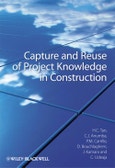Capture and Reuse of Project Knowledge in Construction describes a methodology for the 'live' capture of reusable project knowledge that reflects both the organisational and human dimensions of knowledge capture and reuse, as well as exploiting the benefits of technology. This methodology was developed in response to the shortcomings of current practices in managing project knowledge, the benefits offered by capturing and sharing knowledge immediately after it is generated, and the organisational benefit of reusing knowledge within a project based environment.
Table of Contents
Author detailsPreface
1 Introduction
1.1 Background
1.2 The need for live capture and reuse of project knowledge
1.3 The objectives and contents of the book
2 Knowledge Management – Key Concepts
2.1 Defining knowledge
2.2 Knowledge management
2.2.1 Functionalist vs. interpretivist
2.2.2 Information systems vs. human resource management
2.2.3 Interdisciplinary perspective
2.2.4 Combined soft and hard approaches
2.3 Benefits and barriers to KM
2.4 KM processes
2.4.1 Knowledge capture
2.4.2 Knowledge sharing
2.4.3 Knowledge reuse – adapting and applying
2.4.4 Knowledge maintenance – archiving and retirement
2.5 KM in construction
2.5.1 Shortcomings of current practice
2.5.2 KM research projects in construction
2.6 The importance of ‘live’ capture and reuse of project knowledge
3 Reusable Project Knowledge – Generation and Capture
3.1 Reusable project knowledge
3.1.1 Types of reusable project knowledge
3.1.2 Characteristics of reusable project knowledge
3.2 Learning situations
3.2.1 Formal learning situations
3.2.2 Ad hoc learning situations
3.3 Current practice on capture and reuse of project knowledge
3.3.1 Post project reviews
3.3.2 Communities of Practice
3.3.3 Training
3.3.4 Recruitment
3.3.5 Face-to-face interaction
3.3.6 Mentoring
3.3.7 Succession planning and management
3.3.8 Reassignment of people
3.3.9 Knowledge bases
3.3.10 Intranets
3.3.11 Groupware
3.3.12 Project extranets
3.3.13 Case-based reasoning
3.3.14 Text mining
3.4 Soft issues in KM
3.4.1 People issues
3.4.2 Organisational issues
3.4.3 Cultural issues
3.5 Summary
4 Collaborative Learning in Construction
4.1 Introduction
4.2 Collaborative learning
4.3 CL in construction
4.4 Previous research in CL
4.5 Implementing CL in construction projects
4.6 Summary/conclusions
5 Methodology for Live Knowledge Capture and Reuse of Project Knowledge
5.1 Background of case study companies
5.2 Findings from the case studies
5.2.1 End-users’ requirements for knowledge capture and reuse
5.2.2 Analysis of the end-users’ requirements for knowledge capture and reuse
5.2.3 Current practice for the capture of reusable project knowledge
5.2.4 Analysis of current practice for the capture of reusable project knowledge
5.3 Structure of the ‘live’ capture and reuse of project knowledge methodology
5.3.1 Integrated workflow system
6 The Capri.net System
6.1 System architecture of prototype application
6.2 Development of the Web-based knowledge base
6.2.1 Selection of development environment
6.2.2 User interface and programme codes development
6.2.3 Database design
6.3 Refinement of the IWS and user interface
6.4 Operation of the prototype application
6.4.1 Logging in
6.4.2 Browsing the Summary Page
6.4.3 Exploring the content of the system through the ‘Index Page’
6.4.4 Exploring and validating the details of a knowledge item
6.4.5 Add and Edit project details
6.4.6 Adding new knowledge category and type
6.4.7 Create account for new user
6.4.8 Add New Knowledge
6.4.9 Conducting a search
6.5 Testing and evaluation of Capri.net
6.5.1 Prototype testing
6.5.2 Prototype evaluation
7 Concluding Notes
7.1 Summary
7.2 Conclusions
7.3 Limitations of the research
7.4 Further work
7.5 Concluding remarks
Appendix A Table Comparing the Various Knowledge Management Process Models
Appendix B Details of the Types of Reusable Project Knowledge Identified
Appendix C Additional Learning Situations Related to Change Management, Problem-Solving and Innovation
Appendix D Companies’ Practice and Requirements on Knowledge Representation
References
Index
Samples

LOADING...








